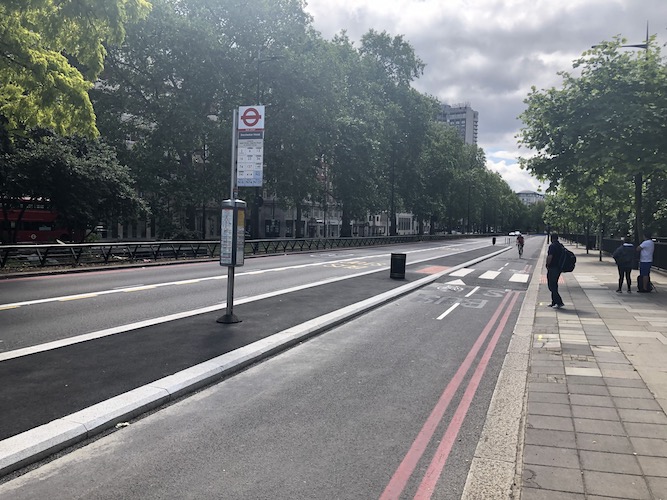When the Mayor and Transport for London announced their Streetspace programme in May 2020, reactions were strong and mixed. City Hall was upbeat, speaking of a “fast-tracked” “transformation of London’s roads” to “accommodate a possible ten-fold increase in cycling and five-fold increase in walking when lockdown restrictions are eased”. Environmental and “active travel” campaigners were delighted, but critics were enraged. Disputes about the efficacy, impacts and popularity of instant new bicycle lanes and Low Traffic Neighbourhoods have been raging ever since.
An early focal point for disagreement was a cycle lane installed on the northbound side of Park Lane – a famous Central London street infamous for fumes and motor traffic congestion. Local Conservative politicians quickly complained about the lane and other changes, saying congestion and pollution levels had become worse than before the first Covid lockdown. A curious feature of this redesign was that it looked built to last. Although the Streetspace schemes were described as “temporary” with the possibility of being made permanent, the Park Lane one had a permanent look about it from the start.
What is the situation one year on? An email from TfL’s public engagement team to people who’ve inquired about the Park Lane “temporary changes” begins with an assurance that “we are aware of the recent increase in congestion in the Park Lane area”. It adds that “early indications from our monitoring” suggest the problem might arise from people “preferring to travel by private transport rather than using public transport.”
The Streetspace changes are dealt with in separate sections of the email, which says “we are seeing hundreds of cyclists a day using the new cycle lane during the week, more so at weekends.” It adds that as London continues to recover from the pandemic TfL will need to “consider whether the temporary changes we introduced to Park Lane last spring should remain in place in the longer term.” If it is decided that there “may be a case for retaining the changes permanently” wide consultation will follow.
The email also addresses the question, raised by sceptics, of why a cycle lane was needed on Park Lane when one already runs parallel to it in Hyde Park. Apparently, the park’s management asked TfL to consider it “in order that they could reduce the number of cyclists using the park, to reduce the possibility for cyclists and pedestrians to impede one another.” In summary, the email says the temporary changes were made “partly to support people cycling here, but also to keep buses running reliably and to reduce the dominance of the car in overall terms.”
Are those objectives being achieved? Are “hundreds” of weekday cyclists sufficient to justify the Park Lane cycle lane being retained? Will that permanent-looking new road infrastructure end up being dug up again? The consultation, if it happens, should be enlightening.
On London is a small but influential website which strives to provide more of the kind of journalism the capital city needs. It depends on financial help from readers and is able to offer them something in return. Please consider becoming a supporter. Details here.


I’ve just stumbled across this article. As someone who uses Park Lane Northbound on most weekdays I find myself getting very frustrated seeing the cycle lane not only empty but there. As motorists we have had the grace to give up a third of our much needed road so that ‘hundreds’ of invisible cyclists can use it for absolutely free.
Cyclists are a menace to legitimate road users. They flout the law frequently. They have no insurance even though they are just as capable of causing damage as cars (I had a friend knocked over and killed by a cyclist 18 months ago). Who’s to say that their ‘vehicles’ are roadworthy? They do not have to have an MOT, they are not licenced, anyone can get on the road in London, for a very small price, having never ridden a bike before! Above all they pay NOTHING towards their journey and expect to take priority on the road. After all the traffic lights are for cars, aren’t they?
Is Mr Khan ever going to come to his senses and realise that moving traffic causes less pollution than standing traffic? The more bus and cycle lanes he introduces, the more pollution will rise as there will be more traffic jams.
The Park Lane cycle track has been a superb addition to London’s cycle network. While it’s not on my daily routes, I ride on it at least once a week, heading either to the Regent’s Park area, Paddington station or around Marble Arch. It’s a huge improvement over the dreadful shared path in Hyde Park, which is constantly filled with runners and wandering tourists. I haven’t seen congestion statistics for the northbound side of Park Lane but it doesn’t look much worse than before, given the big rises in motor traffic since the pandemic. It’s also becoming gradually busier, I notice, as people work out how to integrate it into their routes. I look forward to participating in the consultation and voicing my vigorous support for retaining this hugely useful innovation.
The congestion because of what they have done to the north bound side of park lane is absolutely ridiculous & whoever thought of this is an absolute clown or otherwise known as a pen pusher..its causing tailbacks in 3 different directions gloucester place, gloucester crescent & knightsbridge because Hyde Park roundabout isn’t moving nobody can get round it & it’s all because of park lane